AUCTORES
Globalize your Research
Case Report
*Corresponding Author: Laura Fueyo Suárez, Hospital Universitario de Gran Canaria Doctor Negrin, Barranco de la Ballena s/n, 35010, Las Palmas de Gran Canaria, Spain.
Citation: Laura F. Suárez, Mónica F. Monasterio, Javier F. Palacios, (2023), Gorlin Syndrome: Clinical Features, Pathogenesis and Updated Treatment. A Case Reports, Journal of Clinical Surgery and Research, 4(1); DOI:10.31579/2768-2757/069
Copyright: © 2023, Laura Fueyo Suárez. This is an open access article distributed under the Creative Commons Attribution License, which permits unrestricted use, distribution, and reproduction in any medium, provided the original work is properly cited.
Received: 10 March 2023 | Accepted: 17 March 2023 | Published: 27 March 2023
Keywords: gorlin syndrome; basal cell nevus syndrome; vismodegib; PTCH1
Aim: to present an updated review of the diagnosis and treatment of Gorlin Syndrome.
Methods: A bibliographical review was performed on PubMed using the keywords Gorlin syndrome, Basal cell nevus syndrome, Vismodegib, PTCH1. 24 articles out of a total of 2588 articles were fully reviewed, with 3 more being partially considered based on relevant content.
Results: Our patient was operated several times, with a total of 31 lesions being removed, all of which were confirmed pathologically as basal cell carcinomas (BCC). After several recurrences, locally advanced BCCs and multiple new lesions presenting in every visit, the case was considered not manageable through surgery alone and adjuvant Vismodegib treatment was suggested. The patient declined due to its side effects and is currently under observation.
Discussion: Gorlin syndrome is a rare entity that presents in one of every 56,000 adults. It is autosomal dominant without sex-biased prevalence. It is primarily associated to the PTCH1 tumor suppressor gene, located in chromosome 9q22.3-q31. The appearance of multiple BCCs is influenced by multiple risk factors such as solar exposure and radiotherapy, which can increase the rate of new lesions. The first treatment choice is surgery, with locally advanced or recurring carcinomas being treatable with a systemic inhibitor of the Hedgehog signaling pathway as an adjuvant trearment. The main limiting factor of the use of Vismodegib is its adverse side effects, though they are known to diminish over time. New treatments under study include intermittent Vismodegib treatment and topical use of inhibitors of the Hedgehog pathway, which could potentially reduce side effects and impact patient prognosis.
Conclusions: Treatment of patients with Gorlin Syndrome is multidisciplinary, and conditioned by the constant development of new carcinomas. This sometimes requires the use of systemic treatments, which present a high number of side effects that limit their use. In recent times, new topical drugs that inhibit the Hedgehog pathway are under study. These have a lower rate of side effects and could become an effective treatment alternative.
Gorlin syndrome, also known as Nevoid Basal Cell Carcinoma Syndrome (NBCCS), is a rare genetic disorder characterized by the development of multiple basal cell carcinomas from a young age [1]. Their clinical behavior is variable and, in some cases, locally aggressive. Other common symptoms are odontogenic keratocysts, palmar and plantar pits, skeletal malformations, and abnormalities in development, making a multidisciplinary approach necessary for this disorder [2]. NBCCS has autosomal dominant inheritance with variable expression and penetrance, and it is caused by mutations on the Sonic Hedgehog signaling pathway. The best known of these mutations is the deactivation of the PTCH1 tumor suppressor gene, located in chromosome 9q22.3-q3 [13]. The diagnosis of this syndrome is clinical and based on a set of major and minor criteria4, and it can be confirmed through direct analysis of the genetic mutation5. The gold standard treatment is the surgical resection of the BCCs, although a high number of locally aggressive or recurrent lesions warrant the use of systemic treatments, despite their adverse effects, in order to prevent the appearance of new lesions. The objective of this article is to review the bibliography of the currently published papers on Gorlin syndrome, its pathogenic development, clinical characteristics, and therapeutic management, through the study of a complex case diagnosed and treated in our department. Through this, we aim to analyze in detail the current knowledge on this infrequent entity and evaluate its current and future management alternatives.
A bibliographical search was performed in PubMed with the following keywords: Gorlin syndrome, Basal cell nevus syndrome, Vismodegib, PTCH1. 24 articles out of a total of 2588 articles were fully reviewed, with 3 more being partially considered based on relevant content. A case study, operated on by our department, is presented, along with the experience acquired through its management.
A 48-year-old male presents to our Plastic Surgery department with a history of six lesions resected by the Dermatology department throughout the past ten years, all of them with the anatomopathological result of basal cell carcinoma (BCC). The patient also had a record of several removed odontogenic keratocysts in the maxillary sinus and mandible. Palmar and plantar pits, as well as macrocephaly were observed during physical examination. The patient matched three major and one minor criteria, and thus a clinical diagnosis of Gorlin syndrome was established.
The patient was referred to our department due to a large, ulcerated, piercing lesion of pearly edges with arborizing telangiectasias, compatible with BCC, in the left orbital region, having produced ocular atrophy and blindness. An exenteration of the orbit was performed and covered with an anterolateral thigh flap (ALT). Furthermore, the patient presented multiple lesions compatible with BCC across the surface of his body. These were deferred to be removed after recovery.
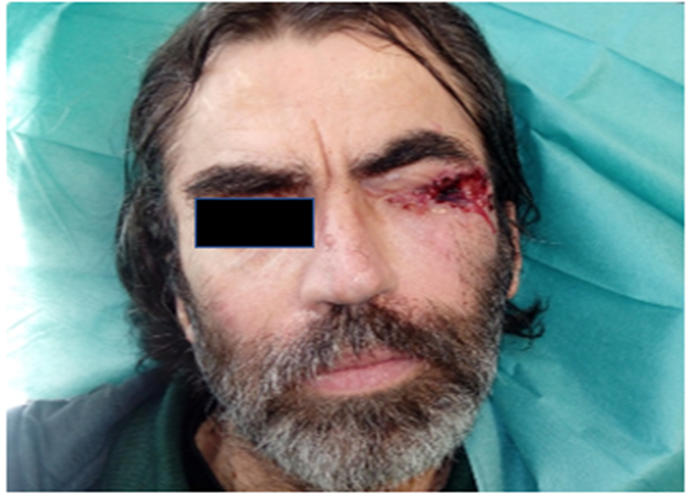
Figure 1: BCC of the left orbital region
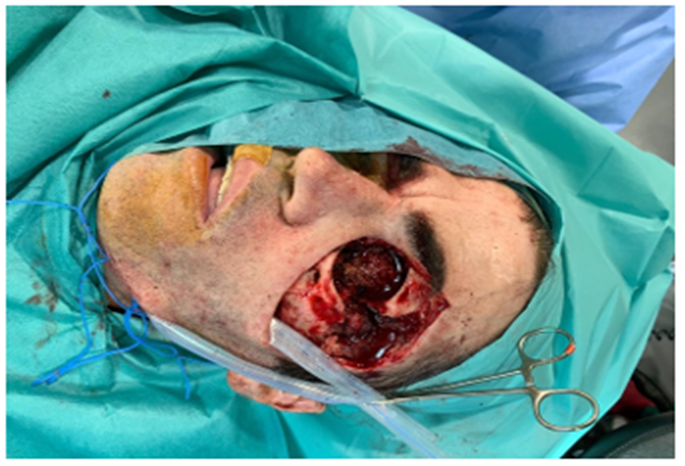
Figure 2: intraoperative orbit exenteration
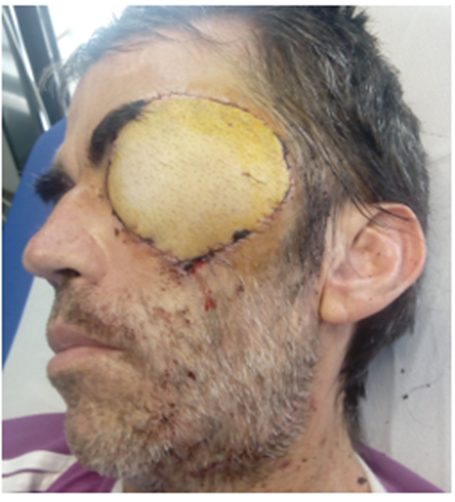
Figure 3: 2 weeks follow up with ALT flap reconstruction
Six months later, the patient underwent excisional biopsy with wide margins for thirteen lesions suspected of being BCCs, the location of which is shown in the following figures. Three of the resected lesions did not respect the resection margins.
Direct closure was performed in most locations, with coverage of the left shoulder being achieved with a myocutaneous pedicled Latissimus Dorsi flap, and the right retroarticular lesion being covered with a preauricular pedicled flap.
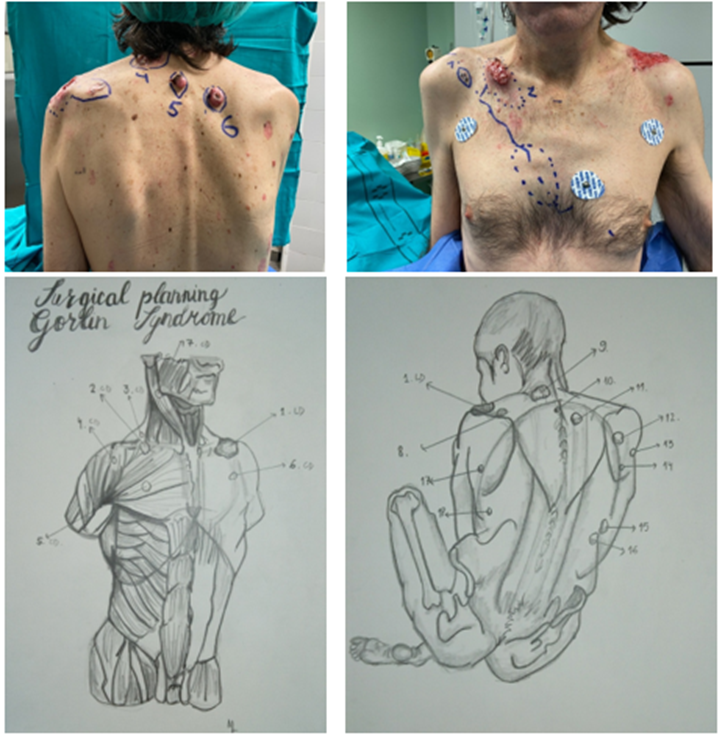
Upon the recurrence and appearance of new lesions, and after having resected a total of twenty BCC (some locally aggressive, others recurrent), it was decided that the patient should be followed up and referred to the Medical Oncology department in our center to consider starting a systemic oral treatment with a Hedgehog pathway inhibitor, Vismodegib. After having informed the patient of the possible adverse effects of the treatment, he refused to receive it.
Three months after the previous surgery, the patient is once again operated on, with four more lesions being removed from the shoulder and dorsal region. Five months later, three more lesions were resected from the nasal dorsum, the right side of the thorax and right side of the back. Finally, in July 2021, four more lesions were removed: one in the left ear and three in the right half of the back. The anatomopathological result of all the removed lesions was BCC.
Today, after a total of thirty-one removed lesions, all of which were compatible with basal cell carcinoma, the patient is being followed up by Medical Oncology and our Plastic Surgery departments, as well as Internal Medicine after having developed constitutional syndrome.
Gorlin syndrome, also known as Nevoid Basal Cell Carcinoma Syndrome (NBCCS), is a rare entity with a prevalence that varies between 1:57,000 and 1:256,000, without distinction by sex6. Several mutations have been identified as playing a part in Gorlin syndrome, found in genes involved in the Sonic Hedgehog cell proliferation and differentiation pathway. The most common finding is the loss of heterozygosity in PTCH1, followed by PTCH2 and SUFU. The PTCH1 gene, present in chromosome 9q22.3-q31, is a suppressor of this pathway. Therefore, its alteration leads to an uncontrolled cell proliferation [6,7,8].
This syndrome predisposes to the formation of malignancies and developmental abnormalities, with the formation of multiple basal cell carcinomas being particularly notable from early ages of life. These BCCs have a histology and behavior similar to sporadic ones, but it should be noted that, due to their appearance at early ages, it is more common to find locally aggressive lesions owing to their longer evolution time. Nevertheless, it is uncommon to find carcinomas so advanced that they reach the facial bones [2]. It is also common to find odontogenic keratocysts and palmoplantar pits, as well as facial malformations such as hypertelorism, macrocephaly, and cleft lip or palate. Other malignancies also have higher prevalence rates on these patients, such as medulloblastoma, cardiac fibromas or meningiomas [4].
Diagnosis of this syndrome is essentially clinical, requiring either one major criterion plus genetic confirmation, two major criteria, or one major and two minor criteria. Genetic diagnosis would confirm this disease, but it is sometimes not available. It may also be used for genetic counseling [6]. It should be noted that in 20-40% of patients, the mutation occurs de novo without having a family history of the disease [9].
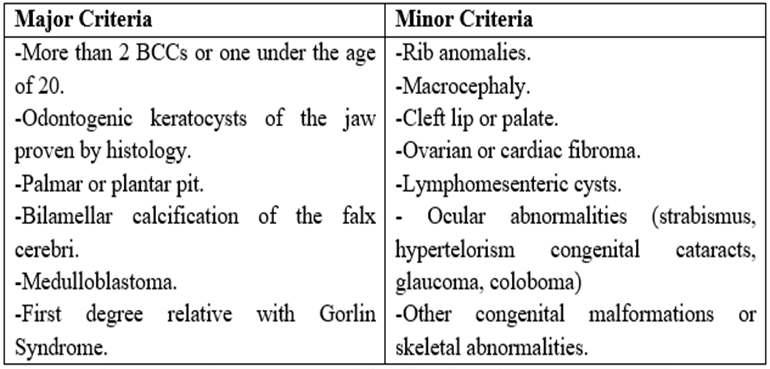
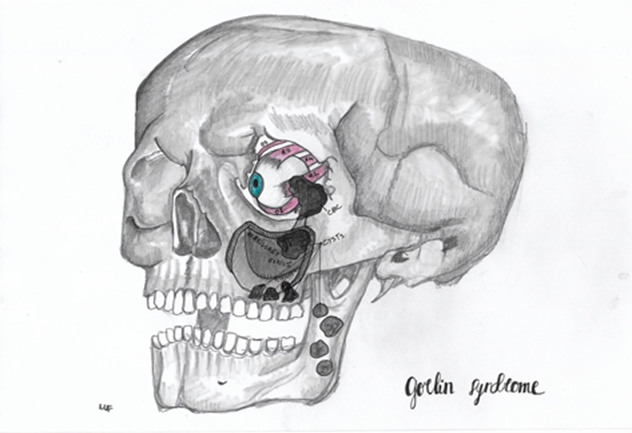
Figure 8: Diagnostic criteria for Gorlin syndrome.
It is important in these patients to avoid exposure to solar radiation and radiotherapy, as they can increase the growth of basal cell carcinomas up to years after exposure to the risk factor. This should be noted when medulloblastoma appears at an early age, as these are usually treated with radiotherapy.
Treatment must be multidisciplinary and tailored to the clinical conditions, with the treatment of choice being surgical removal of the lesions with a 4mm margin. Use of Mohs micrographic surgery is advisable for recurring tumors, or for those affecting high-risk areas such as the face. Small low-risk lesions have seen success with alternatives such as cryotherapy, curettage and electrodessication, CO2 laser, photodynamic therapy, and topical treatments such as Imiquimod cream or 5-fluorouracil cream [1,5,10].
In metastatic, locally advanced, or recurring tumors, systemic treatment with a Hedgehog pathway inhibitor, which is responsible for the pathogenesis of the disease, may be considered. For several years, Sonidegib and Vismodegib have been approved for this indication. It has been shown that oral treatment with Vismodegib 150mg/day reduces the number of new basal cell carcinomas, reduces the size of the existing ones, and reduces the need for further surgical interventions [1]. There are currently no recommendations to reduce the dosage in case of interactions, adverse side effects and intolerance. Before starting systemic treatment with Hedgehog pathway inhibitors, it is necessary to rule out pregnancy and initiate contraception [11].
The main limiting factor for the use of these treatments is their adverse side effects, which are usually moderate, but occur in most patients. Among them, muscle spasms, dysgeusia, weight loss, diarrhea, dysmenorrhea, fatigue, and alopecia stand out. Some severe side effects, present in approximately 25% of patients, are pulmonary embolisms, pneumonia, and heart failure, increasing mortality up to 11% [8,12,13]. Certain side effects can be treated or alleviated through a multidisciplinary approach involving nutritionists, rehabilitators, neurologists, dermatologists, physical therapists, and clinical pharmacologists, and can be treated with supplements, spasmolytics, and applying heat or cold. Some adverse effects are resolved several months after the start of the treatment: muscle spasms are usually decrease after 1 to 3 months of treatment, while dysgeusia and alopecia are usually resolved from half to one year later. Despite this, adverse effects are responsible for up to 70% of patients discontinuing treatment [14].
Several clinical trials have been conducted in which the effects of intermittent therapy with Vismodegib in patients with multiple basal cell carcinomas were studied, excluding locally advanced and metastatic ones not susceptible to surgical treatment or radiotherapy. This type of therapy does not interfere, according to the studies, with the efficacy of the drug, while it appears to decrease the rate of side effects and increases patient tolerance to treatment [15].
Currently, research is being conducted on topical therapy with Hedgehog pathway inhibitors. The use of LDE225 0,75% cream, in two daily topical applications, has reduced the volume of existing tumors, induced the disappearance of some and inhibiting the formation of new carcinomas, with good tolerance and fewer adverse side effects [16]. Use of topical Patidegib gel has the potential to prevent and reduce the rate of basal cell carcinomas in patients with Gorlin syndrome without causing hair loss, dysgeusia and muscle cramps [17]. Itraconazole gel 0.7% twice daily is also being studied. At this dose, this drug does not appear to have significant differences with other treatments, but it may be an effective therapy at higher doses [18].
Gorlin syndrome is a challenging. Diagnosis, management, and treatment must be included in a cohesive multidisciplinary approach. While a range of medical and surgical treatment alternatives exist for low-risk lesions, the relentless development of new tumors of poor prognosis sometimes makes systemic treatment necessary. Oral treatment with Hedgehog pathway inhibitors, which block the pathogenic source of the syndrome, allow for a new therapeutic approach, although their side effects impact their effectiveness and limit their use. Currently, new topical inhibitors of the pathway are being studied, which seem to offer a similar efficacy with fewer side effects, representing a potential new alternative for managing these patients in the near future.
Clearly Auctoresonline and particularly Psychology and Mental Health Care Journal is dedicated to improving health care services for individuals and populations. The editorial boards' ability to efficiently recognize and share the global importance of health literacy with a variety of stakeholders. Auctoresonline publishing platform can be used to facilitate of optimal client-based services and should be added to health care professionals' repertoire of evidence-based health care resources.

Journal of Clinical Cardiology and Cardiovascular Intervention The submission and review process was adequate. However I think that the publication total value should have been enlightened in early fases. Thank you for all.

Journal of Women Health Care and Issues By the present mail, I want to say thank to you and tour colleagues for facilitating my published article. Specially thank you for the peer review process, support from the editorial office. I appreciate positively the quality of your journal.
Journal of Clinical Research and Reports I would be very delighted to submit my testimonial regarding the reviewer board and the editorial office. The reviewer board were accurate and helpful regarding any modifications for my manuscript. And the editorial office were very helpful and supportive in contacting and monitoring with any update and offering help. It was my pleasure to contribute with your promising Journal and I am looking forward for more collaboration.

We would like to thank the Journal of Thoracic Disease and Cardiothoracic Surgery because of the services they provided us for our articles. The peer-review process was done in a very excellent time manner, and the opinions of the reviewers helped us to improve our manuscript further. The editorial office had an outstanding correspondence with us and guided us in many ways. During a hard time of the pandemic that is affecting every one of us tremendously, the editorial office helped us make everything easier for publishing scientific work. Hope for a more scientific relationship with your Journal.

The peer-review process which consisted high quality queries on the paper. I did answer six reviewers’ questions and comments before the paper was accepted. The support from the editorial office is excellent.

Journal of Neuroscience and Neurological Surgery. I had the experience of publishing a research article recently. The whole process was simple from submission to publication. The reviewers made specific and valuable recommendations and corrections that improved the quality of my publication. I strongly recommend this Journal.

Dr. Katarzyna Byczkowska My testimonial covering: "The peer review process is quick and effective. The support from the editorial office is very professional and friendly. Quality of the Clinical Cardiology and Cardiovascular Interventions is scientific and publishes ground-breaking research on cardiology that is useful for other professionals in the field.

Thank you most sincerely, with regard to the support you have given in relation to the reviewing process and the processing of my article entitled "Large Cell Neuroendocrine Carcinoma of The Prostate Gland: A Review and Update" for publication in your esteemed Journal, Journal of Cancer Research and Cellular Therapeutics". The editorial team has been very supportive.

Testimony of Journal of Clinical Otorhinolaryngology: work with your Reviews has been a educational and constructive experience. The editorial office were very helpful and supportive. It was a pleasure to contribute to your Journal.

Dr. Bernard Terkimbi Utoo, I am happy to publish my scientific work in Journal of Women Health Care and Issues (JWHCI). The manuscript submission was seamless and peer review process was top notch. I was amazed that 4 reviewers worked on the manuscript which made it a highly technical, standard and excellent quality paper. I appreciate the format and consideration for the APC as well as the speed of publication. It is my pleasure to continue with this scientific relationship with the esteem JWHCI.

This is an acknowledgment for peer reviewers, editorial board of Journal of Clinical Research and Reports. They show a lot of consideration for us as publishers for our research article “Evaluation of the different factors associated with side effects of COVID-19 vaccination on medical students, Mutah university, Al-Karak, Jordan”, in a very professional and easy way. This journal is one of outstanding medical journal.
Dear Hao Jiang, to Journal of Nutrition and Food Processing We greatly appreciate the efficient, professional and rapid processing of our paper by your team. If there is anything else we should do, please do not hesitate to let us know. On behalf of my co-authors, we would like to express our great appreciation to editor and reviewers.

As an author who has recently published in the journal "Brain and Neurological Disorders". I am delighted to provide a testimonial on the peer review process, editorial office support, and the overall quality of the journal. The peer review process at Brain and Neurological Disorders is rigorous and meticulous, ensuring that only high-quality, evidence-based research is published. The reviewers are experts in their fields, and their comments and suggestions were constructive and helped improve the quality of my manuscript. The review process was timely and efficient, with clear communication from the editorial office at each stage. The support from the editorial office was exceptional throughout the entire process. The editorial staff was responsive, professional, and always willing to help. They provided valuable guidance on formatting, structure, and ethical considerations, making the submission process seamless. Moreover, they kept me informed about the status of my manuscript and provided timely updates, which made the process less stressful. The journal Brain and Neurological Disorders is of the highest quality, with a strong focus on publishing cutting-edge research in the field of neurology. The articles published in this journal are well-researched, rigorously peer-reviewed, and written by experts in the field. The journal maintains high standards, ensuring that readers are provided with the most up-to-date and reliable information on brain and neurological disorders. In conclusion, I had a wonderful experience publishing in Brain and Neurological Disorders. The peer review process was thorough, the editorial office provided exceptional support, and the journal's quality is second to none. I would highly recommend this journal to any researcher working in the field of neurology and brain disorders.

Dear Agrippa Hilda, Journal of Neuroscience and Neurological Surgery, Editorial Coordinator, I trust this message finds you well. I want to extend my appreciation for considering my article for publication in your esteemed journal. I am pleased to provide a testimonial regarding the peer review process and the support received from your editorial office. The peer review process for my paper was carried out in a highly professional and thorough manner. The feedback and comments provided by the authors were constructive and very useful in improving the quality of the manuscript. This rigorous assessment process undoubtedly contributes to the high standards maintained by your journal.

International Journal of Clinical Case Reports and Reviews. I strongly recommend to consider submitting your work to this high-quality journal. The support and availability of the Editorial staff is outstanding and the review process was both efficient and rigorous.

Thank you very much for publishing my Research Article titled “Comparing Treatment Outcome Of Allergic Rhinitis Patients After Using Fluticasone Nasal Spray And Nasal Douching" in the Journal of Clinical Otorhinolaryngology. As Medical Professionals we are immensely benefited from study of various informative Articles and Papers published in this high quality Journal. I look forward to enriching my knowledge by regular study of the Journal and contribute my future work in the field of ENT through the Journal for use by the medical fraternity. The support from the Editorial office was excellent and very prompt. I also welcome the comments received from the readers of my Research Article.

Dear Erica Kelsey, Editorial Coordinator of Cancer Research and Cellular Therapeutics Our team is very satisfied with the processing of our paper by your journal. That was fast, efficient, rigorous, but without unnecessary complications. We appreciated the very short time between the submission of the paper and its publication on line on your site.

I am very glad to say that the peer review process is very successful and fast and support from the Editorial Office. Therefore, I would like to continue our scientific relationship for a long time. And I especially thank you for your kindly attention towards my article. Have a good day!

"We recently published an article entitled “Influence of beta-Cyclodextrins upon the Degradation of Carbofuran Derivatives under Alkaline Conditions" in the Journal of “Pesticides and Biofertilizers” to show that the cyclodextrins protect the carbamates increasing their half-life time in the presence of basic conditions This will be very helpful to understand carbofuran behaviour in the analytical, agro-environmental and food areas. We greatly appreciated the interaction with the editor and the editorial team; we were particularly well accompanied during the course of the revision process, since all various steps towards publication were short and without delay".

I would like to express my gratitude towards you process of article review and submission. I found this to be very fair and expedient. Your follow up has been excellent. I have many publications in national and international journal and your process has been one of the best so far. Keep up the great work.

We are grateful for this opportunity to provide a glowing recommendation to the Journal of Psychiatry and Psychotherapy. We found that the editorial team were very supportive, helpful, kept us abreast of timelines and over all very professional in nature. The peer review process was rigorous, efficient and constructive that really enhanced our article submission. The experience with this journal remains one of our best ever and we look forward to providing future submissions in the near future.

I am very pleased to serve as EBM of the journal, I hope many years of my experience in stem cells can help the journal from one way or another. As we know, stem cells hold great potential for regenerative medicine, which are mostly used to promote the repair response of diseased, dysfunctional or injured tissue using stem cells or their derivatives. I think Stem Cell Research and Therapeutics International is a great platform to publish and share the understanding towards the biology and translational or clinical application of stem cells.

I would like to give my testimony in the support I have got by the peer review process and to support the editorial office where they were of asset to support young author like me to be encouraged to publish their work in your respected journal and globalize and share knowledge across the globe. I really give my great gratitude to your journal and the peer review including the editorial office.

I am delighted to publish our manuscript entitled "A Perspective on Cocaine Induced Stroke - Its Mechanisms and Management" in the Journal of Neuroscience and Neurological Surgery. The peer review process, support from the editorial office, and quality of the journal are excellent. The manuscripts published are of high quality and of excellent scientific value. I recommend this journal very much to colleagues.

Dr.Tania Muñoz, My experience as researcher and author of a review article in The Journal Clinical Cardiology and Interventions has been very enriching and stimulating. The editorial team is excellent, performs its work with absolute responsibility and delivery. They are proactive, dynamic and receptive to all proposals. Supporting at all times the vast universe of authors who choose them as an option for publication. The team of review specialists, members of the editorial board, are brilliant professionals, with remarkable performance in medical research and scientific methodology. Together they form a frontline team that consolidates the JCCI as a magnificent option for the publication and review of high-level medical articles and broad collective interest. I am honored to be able to share my review article and open to receive all your comments.

“The peer review process of JPMHC is quick and effective. Authors are benefited by good and professional reviewers with huge experience in the field of psychology and mental health. The support from the editorial office is very professional. People to contact to are friendly and happy to help and assist any query authors might have. Quality of the Journal is scientific and publishes ground-breaking research on mental health that is useful for other professionals in the field”.

Dear editorial department: On behalf of our team, I hereby certify the reliability and superiority of the International Journal of Clinical Case Reports and Reviews in the peer review process, editorial support, and journal quality. Firstly, the peer review process of the International Journal of Clinical Case Reports and Reviews is rigorous, fair, transparent, fast, and of high quality. The editorial department invites experts from relevant fields as anonymous reviewers to review all submitted manuscripts. These experts have rich academic backgrounds and experience, and can accurately evaluate the academic quality, originality, and suitability of manuscripts. The editorial department is committed to ensuring the rigor of the peer review process, while also making every effort to ensure a fast review cycle to meet the needs of authors and the academic community. Secondly, the editorial team of the International Journal of Clinical Case Reports and Reviews is composed of a group of senior scholars and professionals with rich experience and professional knowledge in related fields. The editorial department is committed to assisting authors in improving their manuscripts, ensuring their academic accuracy, clarity, and completeness. Editors actively collaborate with authors, providing useful suggestions and feedback to promote the improvement and development of the manuscript. We believe that the support of the editorial department is one of the key factors in ensuring the quality of the journal. Finally, the International Journal of Clinical Case Reports and Reviews is renowned for its high- quality articles and strict academic standards. The editorial department is committed to publishing innovative and academically valuable research results to promote the development and progress of related fields. The International Journal of Clinical Case Reports and Reviews is reasonably priced and ensures excellent service and quality ratio, allowing authors to obtain high-level academic publishing opportunities in an affordable manner. I hereby solemnly declare that the International Journal of Clinical Case Reports and Reviews has a high level of credibility and superiority in terms of peer review process, editorial support, reasonable fees, and journal quality. Sincerely, Rui Tao.

Clinical Cardiology and Cardiovascular Interventions I testity the covering of the peer review process, support from the editorial office, and quality of the journal.

Clinical Cardiology and Cardiovascular Interventions, we deeply appreciate the interest shown in our work and its publication. It has been a true pleasure to collaborate with you. The peer review process, as well as the support provided by the editorial office, have been exceptional, and the quality of the journal is very high, which was a determining factor in our decision to publish with you.
The peer reviewers process is quick and effective, the supports from editorial office is excellent, the quality of journal is high. I would like to collabroate with Internatioanl journal of Clinical Case Reports and Reviews journal clinically in the future time.

Clinical Cardiology and Cardiovascular Interventions, I would like to express my sincerest gratitude for the trust placed in our team for the publication in your journal. It has been a true pleasure to collaborate with you on this project. I am pleased to inform you that both the peer review process and the attention from the editorial coordination have been excellent. Your team has worked with dedication and professionalism to ensure that your publication meets the highest standards of quality. We are confident that this collaboration will result in mutual success, and we are eager to see the fruits of this shared effort.

Dear Dr. Jessica Magne, Editorial Coordinator 0f Clinical Cardiology and Cardiovascular Interventions, I hope this message finds you well. I want to express my utmost gratitude for your excellent work and for the dedication and speed in the publication process of my article titled "Navigating Innovation: Qualitative Insights on Using Technology for Health Education in Acute Coronary Syndrome Patients." I am very satisfied with the peer review process, the support from the editorial office, and the quality of the journal. I hope we can maintain our scientific relationship in the long term.
Dear Monica Gissare, - Editorial Coordinator of Nutrition and Food Processing. ¨My testimony with you is truly professional, with a positive response regarding the follow-up of the article and its review, you took into account my qualities and the importance of the topic¨.

Dear Dr. Jessica Magne, Editorial Coordinator 0f Clinical Cardiology and Cardiovascular Interventions, The review process for the article “The Handling of Anti-aggregants and Anticoagulants in the Oncologic Heart Patient Submitted to Surgery” was extremely rigorous and detailed. From the initial submission to the final acceptance, the editorial team at the “Journal of Clinical Cardiology and Cardiovascular Interventions” demonstrated a high level of professionalism and dedication. The reviewers provided constructive and detailed feedback, which was essential for improving the quality of our work. Communication was always clear and efficient, ensuring that all our questions were promptly addressed. The quality of the “Journal of Clinical Cardiology and Cardiovascular Interventions” is undeniable. It is a peer-reviewed, open-access publication dedicated exclusively to disseminating high-quality research in the field of clinical cardiology and cardiovascular interventions. The journal's impact factor is currently under evaluation, and it is indexed in reputable databases, which further reinforces its credibility and relevance in the scientific field. I highly recommend this journal to researchers looking for a reputable platform to publish their studies.

Dear Editorial Coordinator of the Journal of Nutrition and Food Processing! "I would like to thank the Journal of Nutrition and Food Processing for including and publishing my article. The peer review process was very quick, movement and precise. The Editorial Board has done an extremely conscientious job with much help, valuable comments and advices. I find the journal very valuable from a professional point of view, thank you very much for allowing me to be part of it and I would like to participate in the future!”

Dealing with The Journal of Neurology and Neurological Surgery was very smooth and comprehensive. The office staff took time to address my needs and the response from editors and the office was prompt and fair. I certainly hope to publish with this journal again.Their professionalism is apparent and more than satisfactory. Susan Weiner

My Testimonial Covering as fellowing: Lin-Show Chin. The peer reviewers process is quick and effective, the supports from editorial office is excellent, the quality of journal is high. I would like to collabroate with Internatioanl journal of Clinical Case Reports and Reviews.

My experience publishing in Psychology and Mental Health Care was exceptional. The peer review process was rigorous and constructive, with reviewers providing valuable insights that helped enhance the quality of our work. The editorial team was highly supportive and responsive, making the submission process smooth and efficient. The journal's commitment to high standards and academic rigor makes it a respected platform for quality research. I am grateful for the opportunity to publish in such a reputable journal.
My experience publishing in International Journal of Clinical Case Reports and Reviews was exceptional. I Come forth to Provide a Testimonial Covering the Peer Review Process and the editorial office for the Professional and Impartial Evaluation of the Manuscript.
